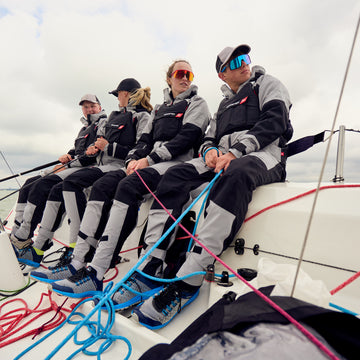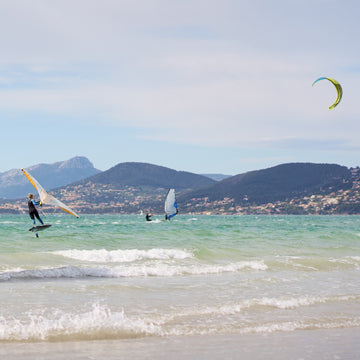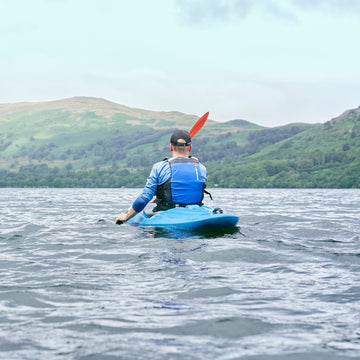After experiencing the 2005 Tyne Tees Laser Qualifier where the UK Laser Standard, Radial and 4.7 fleets found themselves in 54 knots of offshore breeze I felt I should write a short article about some of the top tips I have learned over the years which perhaps we should all be familiar with when conditions get a little out of control for our experience.
I learned my first tip from Mark Littlejohn during my first serious winter sailing the Laser in 1993. We found ourselves in a race with winds occasionally gusting 35+ knots at Chichester Yacht Club Snowflake Series. I was new to the Laser – and found myself using increasing amounts of kicker and Cunningham as the wind increased until I could not pull anymore on! I was sailing upwind with my boom out beyond 1.5m from the corner of the boat – but the boat was uncontrollable, jumping and lurching in each gust. As it became increasingly gusty, I could barely control the power or weather helm. I found myself either stalling head to wind or capsizing in the biggest gusts. Mark seemed to be coping much better than I was. He told me after the race that he had released the kicker and sailed with the boom high in the air. This technique massively reduces your pointing ability, but you can sail confidently without taking a swim.
Technical bit – when you release the kicker and let the boom rise, the mast straightens which takes the fullness (and power) forward; the sail gets fuller and the leach opens. The leach opening reduces the power and the fullness moving forward makes the boat more balanced on the helm. What you feel – you cannot point as high, but the helm is more neutral and the power has mostly evened out. The result– a ‘get you home’ setting in 35+ knots. Remember – the boom is sheeted out – and the sail flaps a lot!!
The second tip I sadly learned myself. I was sailing a Europe at Draycote Water Sailing Club. It was not even a particularly windy day, but I had capsized. Perhaps due to the lightness of the hull and the height, it floated out of the water or perhaps I was just too slow to pull the boat up; but by the time I found myself on the daggerboard, the rig was to windward. Simple you might think – just jump in and cross the boat quickly and stop it capsizing on top of me. Unfortunately, the wind got underneath the sail as the boat came up and it threw the boat at me so quickly that I ended up with 6 stitches. I had heard of a something called the ‘San Francisco roll’, where the sailor hangs onto the centreboard and goes underneath the boat, but never seen it performed, nor had I fancied trying it out. From that day forward I made myself try it out the next time I had the chance, purely from a safety point of view. Don’t think that because you have not tried this that you are less of a person, but I strongly advise you try it so you can add it to your tool kit.
In more challenging conditions that you might experience in the Solent, you can have the wind blowing the hull downwind and the current taking the rig upwind. There may be no other way to pull the boat up with the sails downwind of the hull. So if you have found yourself miraculously making it through the boat without injuring yourself, to the centreboard on the other side and found the only way to pull it up is to use the windage on the hull, then you will have wished that you had learned this technique when the water was warmer, because, with this technique, you CAN get the flappy thing back in the air.
It was much later that I discovered how dangerous sailing can be if you are not equipped with the San Francisco roll. I was the Officer in Charge at a sailing centre in Portsmouth harbour when I let a qualified sailor with his level 3 RYA certificate out on the water in a Laser, after all, he was more qualified than me. On this occasion, the wind increased dramatically for a period and I saw him capsize about 6 times in quick succession. I likened it to a washing machine. He had capsized, turtled. He pulled the boat up and then the wind capsized the boat on top of him. By the time he had scrambled onto the centreboard, the boat was halfway up again and yes it went right over again, and again and again! Poor chap, when we got to rescue him, he was completely knackered! He had never heard of a San Francisco roll.
When you practice this technique for the first time, try and find a competent person to hold the bow 90 degrees to the wind to ensure the boat will flip. Its also super reassuring that they are there.
The last strange safety feature when sailing a Laser – is to wet and dry the centreboard from new. If you don’t, you may find the board too waxy to hang onto when you are it in the water. Be aware that there are rules to modifications to the centreboard, but so long as you are just removing the waxy finish you should be legal and safe.










 Select Store
Select Store
 US
US
 UK
UK
